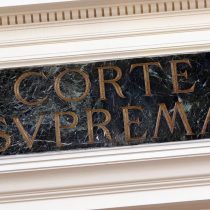
Following the retirement of Supreme Court Justice Guillermo Silva Gundelach, the process of appointing a new person to his post has begun. In this line, the court defines five names, which are proposed to the President of the Republic, who will choose one of them to be ratified by the Senate.
In this regard, in the month in which International Women’s Day is commemorated, it is inevitable to look at the integration of the highest court of justice in the country.
Until now, the Supreme Court was made up of 13 men and 8 women. Thus, although in the Judiciary there is a higher percentage of female representatives who work within it, only 30% do so in the high courts. Are there any formal limitations on them reaching the highest positions? Does it mean that men have more capabilities than us to occupy the highest positions in the judiciary? The answer is no! So how do you explain this?
In the social sciences, the notion of “glass ceiling” has developed, which allows us to affirm that there are certain factors that are hidden, or at least ignored, and that generate discrimination based on gender. This term then describes the invisible barriers that are not simply individual, but generalized, among which are gender stereotypes and representations that, for example, establish masculine as a leadership parameter and consider that women are not suitable for leadership positions. Thus, also the work-family reconciliation that affects different conditions between genders and that culturally imposes a double day (work-family), and the macho culture that assumes that the care roles correspond to mothers, therefore, they are less suitable for challenging positions.
It is worth mentioning the undeniable concern that the institutionality of the Judiciary has had in matters of gender equality, which led it to create the Technical Secretariat for Gender Equality and Non-Discrimination, and to adopt in 2018 a Policy of Gender Equality and Non-Discrimination. However, significant gaps still exist within it in women’s access to higher positions.
In this scenario, the challenge is posed to review the measures that are necessary to implement to break down gender barriers, so that in this and future job selection processes, gender equality crosses the decisions and is not relegated to a day of commemoration or to the goodwill of those who decide, but that it is considered obligatorily in all selection processes, making visible those obstacles that limit the court from being even for women.
Conception
Follow us on
The content expressed in this opinion column is the sole responsibility of its author, and does not necessarily reflect the editorial line or position of El Mostrador.
"El reclamo puede ser genuino, pero construido sobre una mentira", apuntó el presidente Javier Milei…
El gobernador de la provincia de Buenos Aires, Axel Kicillof, encabezó un acto en Ensenada…
El diputado nacional de La Libertad Avanza, José Luis Espert, expresó su confianza en la…
Tras la masiva reaparición de Cristina Fernández de Kirchner, el presidente Javier Milei apuntó contra…
El principal propósito de la nueva comisión es evaluar los recursos humanos en el Senado,…
En una medida que busca redefinir las condiciones de los seguros de automóviles en Argentina,…
Esta web usa cookies.